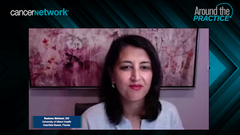
Managing Toxicities and Special Considerations in the Treatment of HER2+ Breast Cancer
The panelists share their insights on managing toxicities and special considerations in the treatment of HER2+ breast cancer.
Episodes in this series

Sara Hurvitz, MD: Before we continue to the next module, I want to highlight that our practice guidelines are rapidly evolving as new data are released. We have new ESMO [European Society for Medical Oncology] 2021 guidelines that place T-DXd [trastuzumab deruxtecan] as a standard second-line therapy for HER2-positive metastatic breast cancer, replacing T-DM1 [trastuzumab emtansine]. T-DM1 can be used if T-DXd is not available, but it’s a strong endorsement for these data. Tucatinib remains a recommendation in the second-line setting for those with brain metastases, being a preferred regimen in that setting, otherwise in the third-line setting. I think we will see the NCCN [National Comprehensive Cancer Network] guidelines evolve very soon as well to incorporate these data. Let’s move on to segment 3 because I would like to discuss some of these issues. One issue is the tolerability of therapy and special considerations, using these agents in older patients, and the different toxicities seen with each of these agents. One question that came through earlier asks, are there any patients for whom you would hesitate to use T-DXd? Dr Mahtani, can you answer that question briefly?
Reshma Mahtani, DO: I would hesitate with patients who have had a history of ILD [interstitial lung disease] or pneumonitis, and patients who I am not confident would report symptoms to me promptly. Otherwise, I can’t think of a scenario where I wouldn’t use it.
Sara Hurvitz, MD: Let’s discuss how you determine treatment for a patient who is elderly. Dr Gadi, does age play a factor, or is it more about performance status and comorbidities?
Vijayakrishna Gadi, MD, PhD: It’s less about age and more about fitness. We all have 50-year-old patients who are 90-year-olds physiologically, and vice versa. I don’t have hard and fast rules around these things. One thing I look for—I know the clinical trials don’t do this, you either have an ECOG [performance status] of 0 or 1, or 3 or greater, and there’s no gray area there. But if the disease is the cause of the low performance status, I’m willing to take the gamble to give them the more active agent to see if I can turn that around. But if it’s poor protoplasm, for example, from a variety of other comorbidities, and the disease is not what’s driving the poor performance status, that’s where I get cautious about using a more toxic agent. You’re doing that calculus every time you sit in front of a patient, that’s the art of oncology, and that’s a harder thing.
Sara Hurvitz, MD: Dr Iyengar, are there comorbidities that make you lean toward one agent and away from another, outside of underlying interstitial fibrosis of the lungs? Are there other comorbidities that sway you toward or away from T-DXd or tucatinib-based therapy?
Neil Iyengar, MD: Outside of the scenario you mentioned, I would say no. There are very specific scenarios, if somebody has an underlying pulmonary disease, like sarcoid for example, manifesting as ground-glass opacities on the CT scan, and I can’t differentiate what’s ILD versus their baseline sarcoid, I would have some pause with T-DXd. Similarly, if somebody has an ongoing immune-mediated diarrheal syndrome, like Crohn disease, I might think twice about a TKI [tyrosine kinase inhibitor] in that setting. There is no general blanket statement other than it’s very patient-specific.
This transcript has been edited for clarity.
Newsletter
Stay up to date on recent advances in the multidisciplinary approach to cancer.

























































































